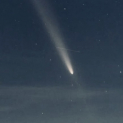Not All Novae Are Super: T Coronae Borealis
In the coming months, a very small constellation in the night sky holds the potential for a once-in-a-lifetime astronomical event that you can witness yourself. If you’re out stargazing this spring and summer, look for the constellation Corona Borealis, or the Northern Crown. (You’ll find it near Draco and Boötes.) Astronomers predict that sometime soon, an obscure star in this constellation will suddenly go from being invisible to the naked eye to shining as brightly as Polaris!
Corona Borealis is about 3,000 light years away and is made up of seven main stars. It is located in the Northern Hemisphere and is visible primarily in spring and summer. Within this constellation is T Coronae Borealis. Known by astronomers as T CrB and also nicknamed “the Blaze star,” this isn’t actually just one star at all, but a binary system. This means two stars are gravitationally bound to each other, orbiting a common center of mass. In a system like this, the larger star would be noted as the primary body in the system and the smaller one is the secondary companion. We are going to use this language to talk about T CrB which has been a hot topic in astronomy the past few months.
The primary star in this system is an ancient red giant star in the very late stages of its life. This red giant has exhausted the hydrogen in its core, causing it to expand and cool. As it swells, it loses mass through a stellar wind, which transfers material to its companion, the secondary star.
The secondary star is a white dwarf, the remnant of a Sun-like star that exhausted its fuel and collapsed under its own gravity. When this star ran out of its fuel source and died, it compressed so densely that it is now only about the size of Earth.
To get an idea of how big of a change that was, going from the size of our Sun to the size of Earth, let’s remember that if we were going to fill up the Sun like a gumball machine with Earths, it would take 1.3 million Earths to fill the Sun. Although the white dwarf went from being roughly Sun-sized to roughly Earth-sized, its mass remains similar to that of the Sun, making it incredibly dense.
So, we have our red giant being slowly stripped of its hydrogen by the strong gravity of our dense, compressed white dwarf. (This is the dramatic process illustrated by image at the top of this page, by NASA/CXC/M.Weiss.) The hydrogen from the red giant accretes on the white dwarf, causing a buildup of pressure and heat as the white dwarf slowly gains even more mass. Eventually, the hydrogen buildup on the white dwarf’s surface reaches a critical temperature, triggering runaway nuclear fusion. The white dwarf stays intact but hurls its excess matter into space—creating a bright flash called a nova that we can see from Earth!
Basically, a nova is just the sudden brightening effect of a star, not to be confused with a supernova event. A supernova is the catastrophic explosion of a star, marking either the final death of a massive star or the thermonuclear detonation of a white dwarf.
In the case of T CrB, this whole relationship dynamic is a cycle, so this blast happens about every 80 years. This is called a recurrent nova.
The process of a recurrent nova can repeat for possibly tens or hundreds of thousands of years. 80 years, as in the case of T CrB, is a fairly short cycle in comparison to some other binary systems that we know of. It’s exciting that this event is happening so close to our own solar system that it is actually visible from Earth by the naked eye.
T CrB nova was first recorded more than 800 years ago! Burchard, abbot of Ursberg in Germany observed “a faint star that for a time shone with great light” in the fall of 1217. It was most recently seen in 1946. Based on observations and behavior over the past few years, some researchers predicted that the nova would recur as early as September 2024. Scientists are actively tracking an increase in brightness, but do not know exactly when the nova will occur. Once it erupts, the outburst will be brief and only visible to the naked eye for about a week.
There is no absolute guarantee that this will happen, but patterns are one of the main ways that discoveries are made in astronomical research. Because you are trying to study things so far away that they are virtually inaccessible, we look for patterns occurring over time. So, either way, astronomers can learn a lot from this event. If for some reason it doesn’t happen when we expect it to, that only ignites more possibility to learn from this system and the interactions of stars.
Let’s take a second to remind ourselves that this binary system is about 3,000 light years away. This is a unit of distance meaning the distance that light travels in one year. Because T CrB is approximately 2,600–3,000 light-years away, the light from its eruption has been traveling for that long before reaching us. Every single time that we look into the night sky, we are getting a glimpse back in time of what the universe once looked like. I think that is a really beautiful and magical thing.
About the Author
Astronomy Programs Manager Ila Jade Komasa has brought her passion for astronomy, physics, and education to her role here at the Museum. Komasa's background in astrophysics research allows her to continue capturing the night sky through astrophotography. From the Gladwin Planetarium to the Palmer Observatory—and all the space between—you can find her sharing her love of astronomy with the community.
Top illustration by NASA/CXC/M.Weiss






2 Comments
Post a CommentEloquent article Ila Jade Komasa. Looking forward to many more.
Ila Jade Komasa has a gift for words that tells the story by the details in the descriptions - great visual for those of us that are neophytes in the astronomy world!